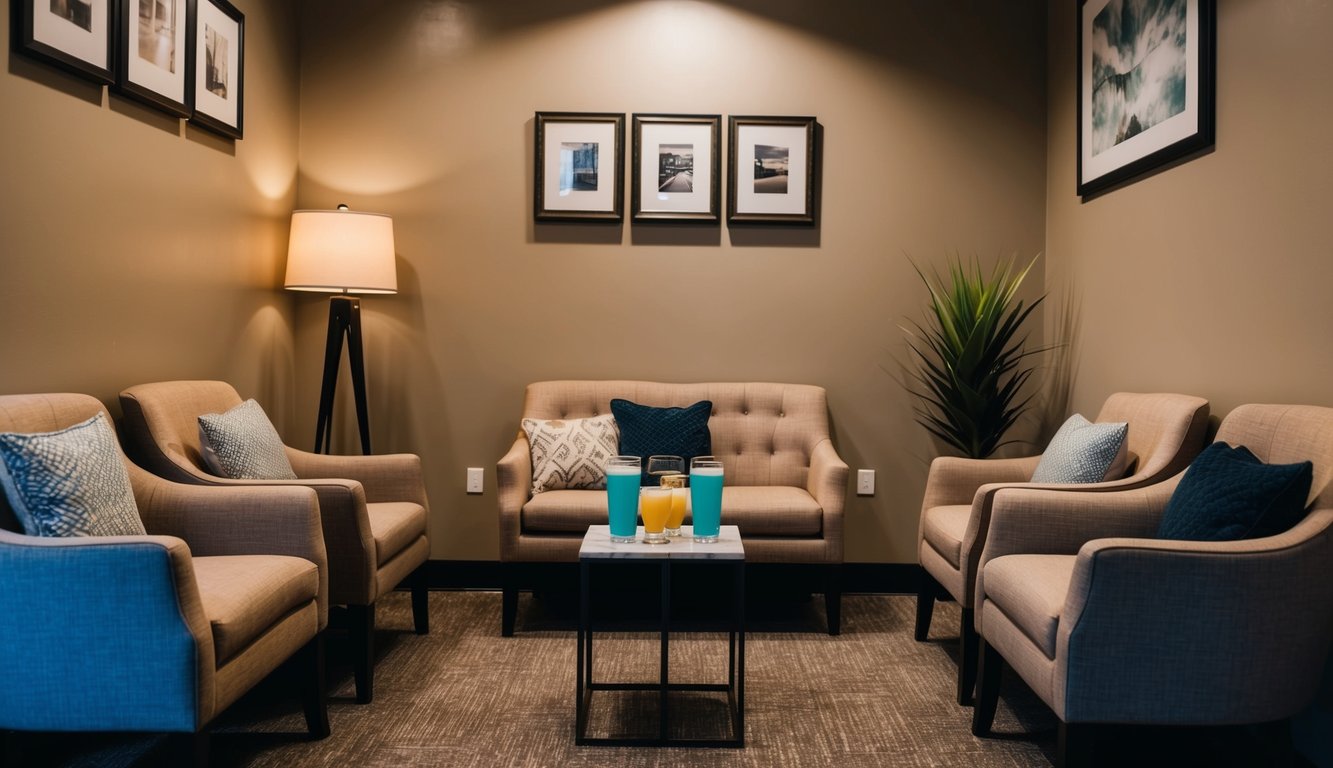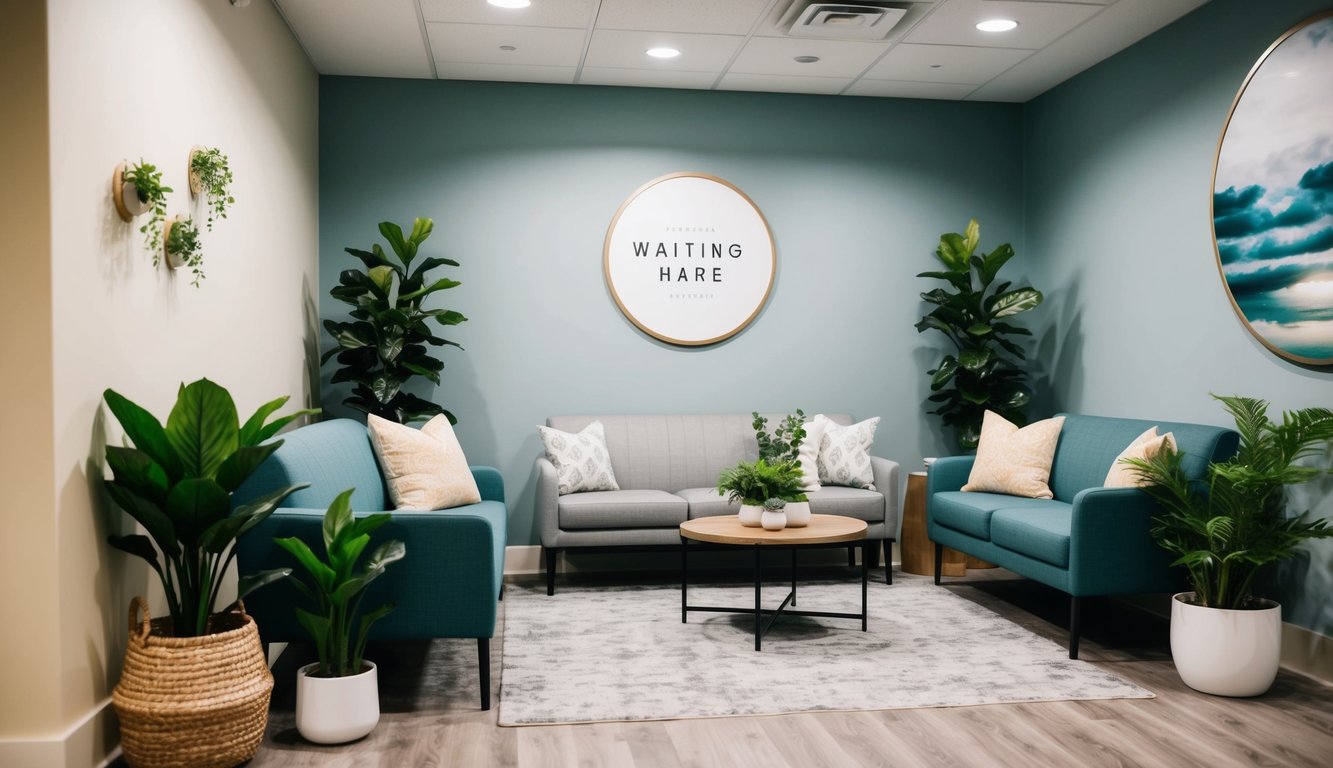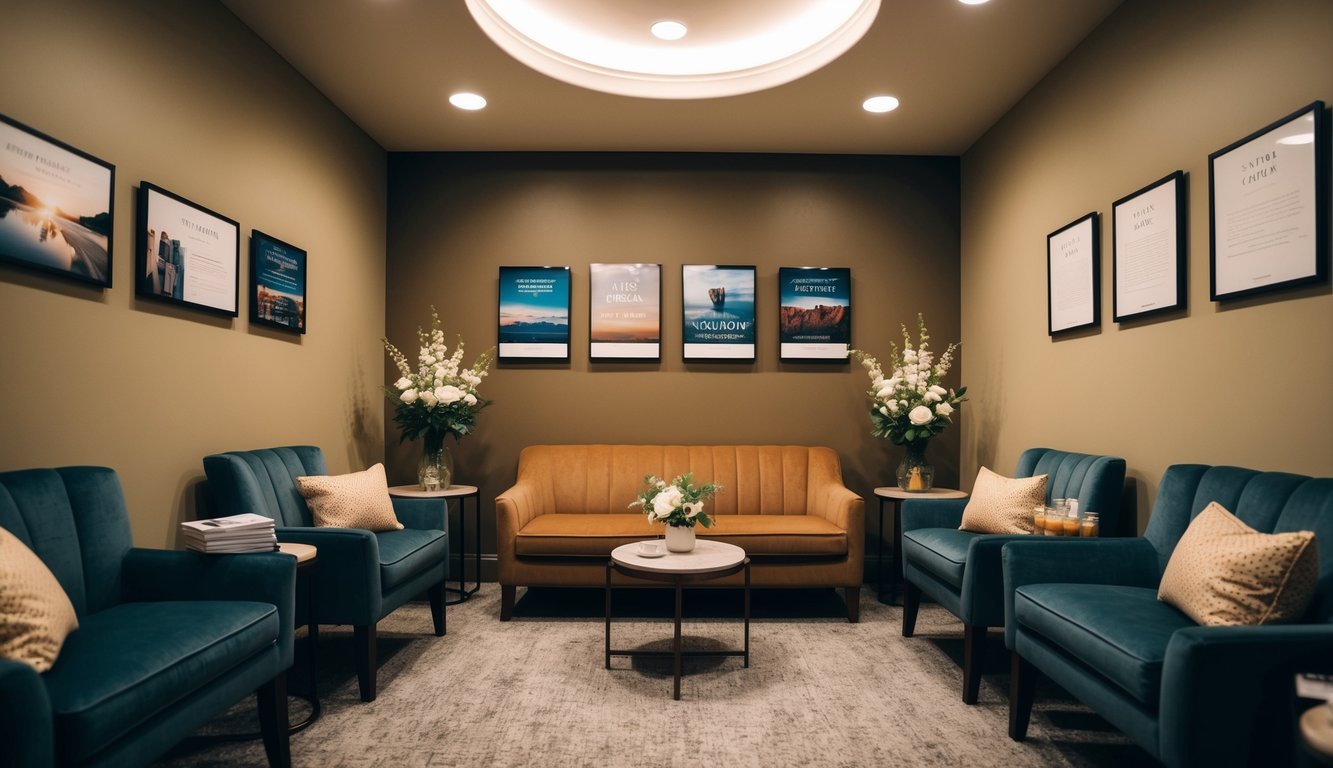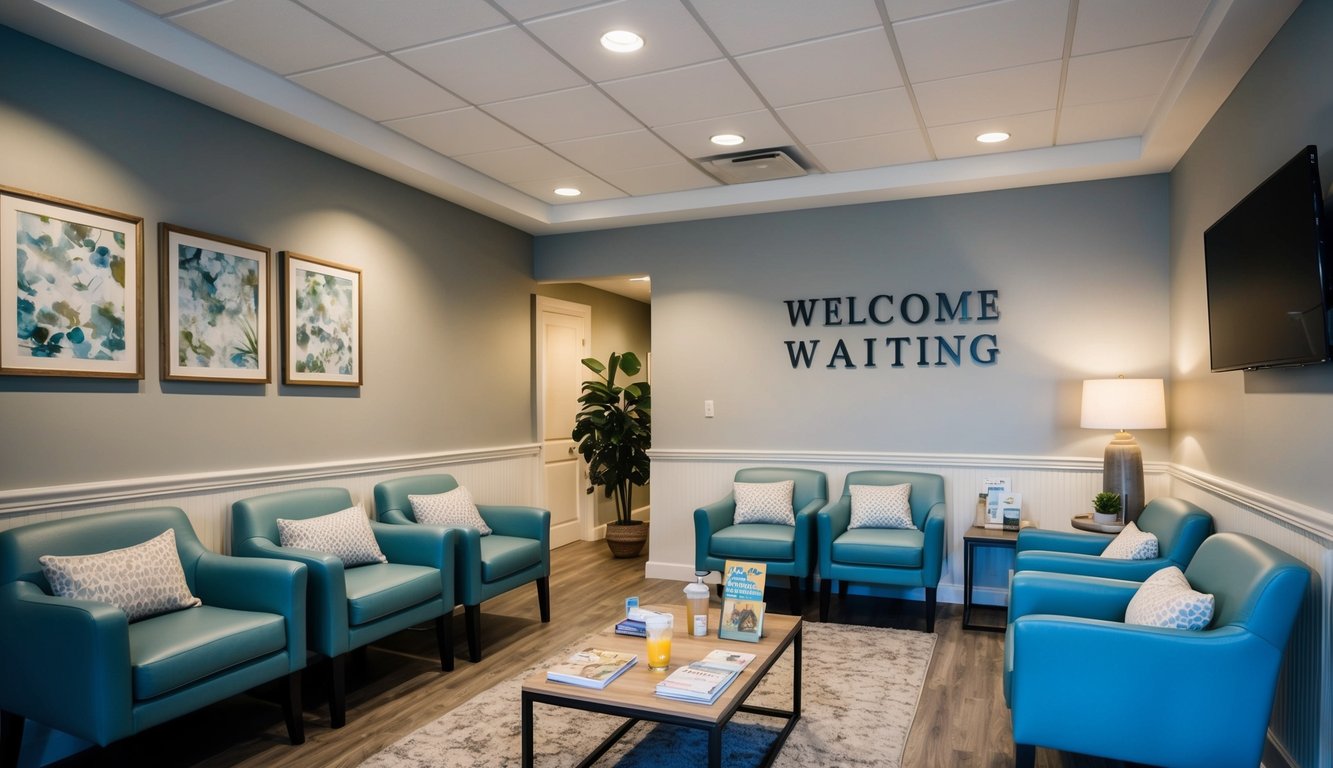Creating a comfortable waiting area is crucial for making clients feel valued and respected. A well-designed waiting space can significantly enhance customer satisfaction. It can also leave a positive first impression of your business.
By focusing on key elements like seating, lighting, and entertainment options, you can transform your waiting area into a welcoming environment that puts clients at ease.

To create an inviting atmosphere, consider incorporating natural light and comfortable seating.
Offer amenities such as complimentary refreshments or Wi-Fi access to make the wait more pleasant.
Pay attention to the layout, ensuring that your receptionist is visible and easily accessible to greet clients upon arrival.
Key Takeaways
- A well-designed waiting area enhances customer satisfaction and creates a positive first impression
- Comfortable seating, natural light, and amenities like refreshments improve the waiting experience
- An easily accessible receptionist helps clients feel welcomed and valued from the moment they arrive
The Importance Of A Welcoming Waiting Area
A welcoming waiting area serves as the first point of contact between you and your clients. It sets the tone for their entire experience with your business.
Creating a pleasant atmosphere can significantly impact how clients perceive your service quality. A well-designed space shows that you value their time and comfort.
Consider these key elements for your waiting area:
- Comfortable seating
- Appropriate lighting
- Engaging entertainment options
- Clean and organized environment
Your waiting room is a reflection of your brand. It can influence client loyalty and potentially lead to positive word-of-mouth recommendations.
A thoughtfully designed space can reduce perceived wait times and minimize client frustration. This can lead to more positive interactions with your staff.
Prioritizing comfort in your waiting area demonstrates your commitment to client satisfaction. It shows that you care about their well-being from the moment they enter your premises.
Designing A Soothing Atmosphere
Creating a calming environment in your waiting area is essential for reducing client stress and anxiety. By carefully considering colors, lighting, and furniture, you can transform the space into a tranquil oasis.
Choosing The Right Colors And Decor
Select a color palette that promotes relaxation and positivity. Soft blues and greens can create a sense of calm, while warm neutrals like beige or light gray offer a soothing backdrop. Avoid bright or intense colors that may feel overwhelming.
Incorporate natural elements to bring a sense of the outdoors inside. Plants or nature-inspired artwork can add a refreshing touch to the space.
Consider using textures like wood or stone to create visual interest and warmth.
Keep decor minimal and purposeful. Choose artwork that is calming and non-controversial. Avoid cluttering the space with too many items, as this can create visual noise and increase stress levels.
The Role Of Lighting In Creating Ambiance
Lighting plays a crucial role in setting the mood of your waiting area.
Opt for soft, diffused lighting rather than harsh fluorescents. Use a combination of ambient, task, and accent lighting to create depth and interest.
Natural light is ideal for promoting a sense of well-being. If possible, maximize window exposure to let in sunlight.
For areas without windows, consider using full-spectrum light bulbs that mimic natural daylight.
Dimmable lights allow you to adjust the brightness throughout the day. Lower light levels in the evening can create a cozy atmosphere, while brighter light during the day helps maintain alertness.
Selecting Comfortable And Functional Furniture
Choose seating that prioritizes comfort and supports good posture. Opt for chairs with ergonomic designs and adequate cushioning.
Include a variety of seating options to accommodate different preferences and needs.
Arrange furniture to create distinct zones within the waiting area. This allows clients to choose between social and more private spaces. Ensure there’s enough space between seating for personal comfort and accessibility.
Include side tables for magazines, drinks, or personal items. Consider adding charging stations or USB ports for client convenience.
Select materials that are durable and easy to clean, maintaining a hygienic environment without sacrificing style.
Incorporating Elements Of Your Healing Philosophy

Your waiting area can reflect your unique approach to healing and therapy. By thoughtfully incorporating elements that align with your philosophy, you create an environment that resonates with your clients and sets the tone for their therapeutic journey.
Showcasing Your Services And Expertise
Display informative materials about your services in the waiting area. Create a calming and inviting space with brochures, posters, or a digital display highlighting your specialties.
Use clear, concise language to describe your therapeutic approaches.
Consider featuring client testimonials or success stories, with permission. These can inspire hope and build trust in your abilities.
Showcase your credentials and certifications tastefully. A small, elegant display of your diplomas and awards can reassure clients of your qualifications without appearing boastful.
Offer a curated selection of self-help books or articles related to your practice. This demonstrates your commitment to ongoing education and empowers clients to take an active role in their healing.
Using Natural Elements To Enhance Tranquility
Incorporate natural elements to create a serene atmosphere that aligns with holistic healing principles.
Add potted plants or a small indoor water feature to bring nature indoors.
Use natural materials like wood, stone, or bamboo in your furniture and decor choices. These elements can ground the space and promote a sense of calm.
Maximize natural light where possible. If windows are limited, use full-spectrum lighting to mimic natural daylight and improve mood.
Consider a nature-themed art display. Landscapes or abstract pieces inspired by nature can evoke feelings of peace and harmony.
Introduce subtle, natural scents like lavender or eucalyptus through essential oil diffusers. Ensure the scent is not overpowering and be mindful of allergies.
Personal Touches That Reflect Your Practice
Add unique elements that represent your therapeutic approach and personal style.
If you focus on mindfulness, include a small meditation corner with cushions and a singing bowl.
Display artwork that aligns with your healing philosophy. Abstract pieces can encourage reflection, while calming landscapes may promote relaxation.
Create a welcoming atmosphere with comfortable, inviting furniture arrangements. Choose colors and textures that reflect your brand and promote a sense of comfort.
Include a community board where you can share inspirational quotes, upcoming workshops, or local mental health resources. This shows your commitment to ongoing support and community engagement.
Consider a small lending library of books related to your therapeutic approach. Encourage clients to borrow and return books, fostering a sense of community and continuous learning.
Practical Tips For A Client-Centered Waiting Area
Creating a welcoming environment in your waiting area can significantly impact client satisfaction. Focus on providing comfort, entertainment, and cleanliness to make clients feel valued and reduce perceived wait times.
Providing Reading Materials And Entertainment
Offer a variety of up-to-date magazines and newspapers covering diverse interests. Include local publications to cater to your community.
Place a selection of books for different age groups, from children’s picture books to adult fiction and non-fiction.
Install a television with closed captions, playing informative content or light entertainment. Ensure the volume is at a comfortable level.
Consider providing tablets with games, puzzles, or educational apps for children and adults.
Set up a complimentary Wi-Fi network with clear login instructions. Place charging stations and outlets throughout the area for client devices.
Offering Refreshments And Comfort Amenities
Install a water cooler or dispenser with disposable cups. Offer a selection of tea and coffee if possible. Consider providing light snacks like individually wrapped mints or cookies.
Ensure comfortable seating with a mix of chairs and sofas to accommodate different preferences. Include some chairs with arms for easier access.
Place coat hooks or a small closet for outerwear. Provide umbrellas for clients to use on rainy days.
Install a white noise machine or soft background music to create a calming atmosphere and enhance privacy. Adjust room temperature to a comfortable level and provide blankets for those who may feel cold.
Ensuring Cleanliness And Organization
Implement a regular cleaning schedule for all surfaces, including seating, tables, and high-touch areas. Use disinfectants and sanitizers approved for public spaces.
Place hand sanitizer stations at entry points and throughout the waiting area. Provide facial tissues and ensure waste bins are easily accessible and regularly emptied.
Organize magazines and other materials neatly on shelves or racks. Remove outdated publications promptly.
Maintain clear walkways and ensure the space is accessible for those with mobility aids. Use plants or decorative elements to create a fresh, inviting atmosphere without cluttering the space.
Regularly inspect furniture and fixtures for damage or wear, repairing or replacing items as needed to maintain a professional appearance.
Building Client Trust And Loyalty Through First Impressions

Creating a positive first impression is crucial for building trust and loyalty with clients. A well-designed waiting area, attentive feedback gathering, and continuous improvement all contribute to making clients feel valued from the moment they enter your space.
The Psychological Impact Of A Well-Designed Waiting Area
A thoughtfully designed waiting area can significantly influence clients’ perceptions of your business. Clean and inviting reception spaces create a sense of professionalism and attention to detail.
Choose comfortable seating arrangements that allow for personal space. Incorporate calming colors and natural elements like plants to reduce stress and anxiety.
Provide amenities such as complimentary refreshments, charging stations, and reading materials to show you value clients’ time and comfort. Ensure proper lighting and temperature control to create a pleasant environment.
Display relevant information about your services or company achievements to build credibility. Use digital displays or artwork that aligns with your brand identity to reinforce a positive image.
How To Gather And Implement Client Feedback
Actively seeking and implementing client feedback demonstrates your commitment to improvement and client satisfaction. Use multiple channels to collect feedback, such as in-person conversations, surveys, and comment cards.
Implement a simple rating system for clients to quickly assess their waiting experience. Follow up with dissatisfied clients to address concerns promptly.
Create a feedback loop by sharing improvements made based on client suggestions. This shows you value their input and are committed to enhancing their experience.
Train your reception staff to engage professionally with clients and gather informal feedback. Encourage them to report common issues or suggestions they hear from clients.
Regularly analyze feedback data to identify trends and prioritize improvements. Use this information to guide decision-making and resource allocation.
Continuous Improvement And Adaptation
Commit to ongoing refinement of your waiting area and client experience. Stay informed about industry trends and best practices in customer service and waiting room design.
Conduct periodic audits of your waiting area to ensure it remains clean, functional, and aligned with your brand image. Replace worn furniture or outdated decor to maintain a fresh appearance.
Invest in staff training to ensure consistent, high-quality interactions with clients. Empower your team to make on-the-spot improvements and handle client concerns effectively.
Consider seasonal adjustments to your waiting area, such as providing umbrella stands during rainy seasons or adjusting temperature controls for comfort year-round.
Regularly update informational materials and entertainment options to keep the waiting experience engaging and relevant for repeat clients.

A well-designed waiting area can significantly impact your clients’ experience. By implementing these strategies, you’ll create a space that not only accommodates but truly welcomes visitors.
Comfortable seating, soothing decor, and engaging entertainment options will help reduce perceived wait times. Your clients will feel valued and appreciated from the moment they step through the door.
Remember to keep your receptionist visible and accessible. This personal touch adds to the welcoming atmosphere and ensures efficient communication.
Regular maintenance and cleanliness are crucial. A tidy, well-organized space reflects positively on your business and shows respect for your clients’ comfort.
By investing in your waiting area, you’re investing in client satisfaction and loyalty. A positive first impression can lead to long-lasting business relationships and word-of-mouth referrals.
Take the time to reassess your waiting area periodically. Client needs may change, and staying adaptable will help you maintain a space that consistently meets and exceeds expectations.
Frequently Asked Questions

Creating a comfortable waiting area involves careful consideration of design elements, furniture selection, and strategies to enhance client satisfaction. Engaging activities and thoughtful ambiance can significantly impact the overall waiting experience.
What elements are essential for designing a comfortable waiting area for clients?
A comfortable waiting area requires adequate seating, proper lighting, and a well-designed layout. Incorporate elements like plants, artwork, and soothing colors to create a calming atmosphere. Ensure accessibility for all clients, including those with mobility challenges.
Consider adding amenities such as charging stations, water dispensers, and reading materials. Temperature control is crucial for maintaining a pleasant environment year-round.
Which type of furniture is recommended to ensure comfort in a client waiting area?
Choose ergonomic chairs with proper back support and cushioning. Opt for a variety of seating options, including individual chairs, loveseats, and benches to accommodate different preferences and group sizes.
Select furniture with durable, easy-to-clean materials. Include side tables for convenience and consider modular pieces that allow for flexible arrangements.
How can businesses improve customer satisfaction during wait times?
Implement a queue management system to organize and streamline the waiting process. Provide clear communication about estimated wait times and keep clients informed of any delays.
Offer complimentary Wi-Fi and refreshments. Train staff to be attentive and responsive to client needs. Regularly gather feedback and make improvements based on client suggestions.
What activities can be provided to engage clients while they wait?
Provide a variety of magazines, newspapers, and books catering to different interests. Install a television with informative or entertaining content relevant to your business.
Set up a small play area for children if appropriate for your clientele. Consider offering tablets with games, puzzles, or educational apps. Display informative posters or digital screens showcasing your products or services.
What strategies can help reduce perceived wait times for customers?
Keep clients engaged with visual stimuli such as artwork or informative displays. Play pleasant background music to create a more relaxing atmosphere.
Provide progress updates and explanations for any delays. Offer self-service kiosks or check-in tablets to give clients a sense of control over their wait time.
In what ways can the ambiance of a waiting area affect client perceptions and comfort?
A well-designed waiting room can significantly impact client perceptions of your business.
Use calming colors and natural elements to create a tranquil environment. Ensure proper lighting with a mix of natural and artificial sources.
You should also control noise levels by using sound-absorbing materials. If space allows, create designated quiet zones.






